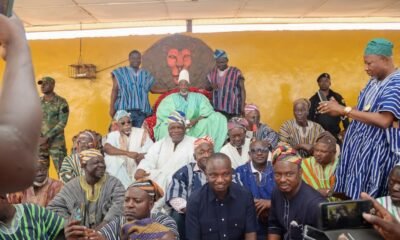News
Amoako-Atta inspects

Government is working to deliver 1,056.9-kilometre road network to the people of the Upper West Region before the end of the year.
These comprise of 471.3km trunk roads, 123.3 km of feeder roads and 132km of urban roads.
Also, plans are underway to award additional 474km of road projects to contractors before the end of the year, involving 36 different projects at different locations.
The Minister for Roads and Highways, Mr kwesi Amoako-Atta announced this at a news conference at Wa over the weekend as part of a day’s working visit to the region.
He indicated that the ongoing construction and the planned projects when completed would amount to 26.4 per cent of work done on roads in the region.
Mr Amoako-Atta said that the Ghana Highways Authority was handling 21 different projects; Department of Feeder Roads was supervising 42 of them, whereas the remaining 15 was under the Department of Urban Roads.
He said the president was committed to working on roads in the country, hence had invested largely in that sector by ensuring that contractors were paid on time to encourage them to expedite action on their respective projects.
The Minister listed among others the construction of major roads such as Tumu-Hamile, Wa-Bulenga, Wa-Han, Fian-Wahabu and Nadowli-Lawra-Hamile roads.
“We are also upgrading Fian-Daffiama-Nadowli, Wa-Chari, Jirapa-Duori, Tumu-Sissili, Tumu-Gwollu-Hamile, Lawra-Han-Tumu roads. We will also rehabilitate the Dorimon-Black Volta, Welembelle-Santijan and Zambo-Kambaa roads as well as some major routes and roads in the Wa Municipality,” he said.
Mr Amoako-Atta indicated that good road network was a requisite for national development, hence the quest for government to work on all roads across the country.
“It is not a mere coincidence that government has labelled 2020 as the year of roads. Government is tackling all sectors of road construction to meet the high demand for good roads in the country, because road infrastructure is very key in the development of the country,” he explained.
The Minister flanked by his Deputy, Mr Anthony Abeifaa Karbo, the Regional Minister, Dr Hafiz Bin Salih and some heads of departments as well as staff of the Ministry of Roads and Highways toured some projects sites to inspect the ongoing construction of roads.
At Lawra, the Minister and his entourage inspected the broken Dekpe bridge and pledged government’s commitment to constructing the bridge to facilitate trade between Ghana and Burkina Faso.
The minister rounded up his tour at Tumu where he described work done by the various contractors as satisfactory, and called on residents to ensure that road signs were not used as scrap by some unscrupulous people.
Source: Ghanaian Times
News
Government, GoldFields,reach agreement on Damang Mine

The Government of Ghana and Goldfields Ghana Limited have reached an amicable agreement on a transitional plan for the Damang Mine.
The operational modalities of the transition involve issuing a new 12-month mining lease to Goldfields’ subsidiary, Abosso Goldfields Limited, pending parliamentary ratification in
May 2025.
Under the new arrangement, Goldfields will resume open-pit mining during the transition period, safeguarding jobs and conducting feasibility studies to establish Damang’s reserves and mine life.
At the same time, the processing of existing stockpiles will continue under the supervision of a joint management team composed of representatives from the Government of Ghana
and Goldfields. The two parties will work in good faith to secure a successful transition and eventual transfer of a viable mine to Ghanaian ownership.
Both parties have agreed to advance discussions in good faith on the renewal of the lease for the Tarkwa mine, due in 2027, and pledged to work together to enhance Ghana’s
potential in the mining sector as a favourable investment destination,
News
Ophelia Crossland appointed as new Creative Director of Nineteen57

In an exciting turn for Ghana’s fashion industry, celebrated designer Ophelia Crossland has officially assumed leadership of Nineteen57, the iconic menswear brand founded by her husband, Kofi Okyere-Darko (KOD).
This transition follows KOD’s recent appointment as Director of Diaspora Affairs at the Office of the President—a prestigious national role that reflects his continued service to Ghana on a global scale.
With this new chapter in public service, the reins of Nineteen57 have now passed to Ophelia Crossland, who will take on both the day-to-day operations and creative direction of the brand.
Ophelia Crossland, the CEO and founder of her eponymous womenswear label, brings over a decade of experience in luxury fashion.
Known for her keen eye for detail and mastery in haute couture, her leadership is expected to usher in a new era for Nineteen57—one that blends timeless African sophistication with modern sensibilities for the stylish gentleman.
“Nineteen57 has always stood for bold sophistication and African excellence,” said Ophelia Crossland. I’m excited to build on that legacy and explore new creative horizons with the team,” she said.
The transition marks a defining moment for the fashion power couple—Ophelia taking the creative lead in fashion innovation while KOD serves the nation in his new diplomatic role.
Together, they continue to elevate Ghana’s presence across fashion and governance.







